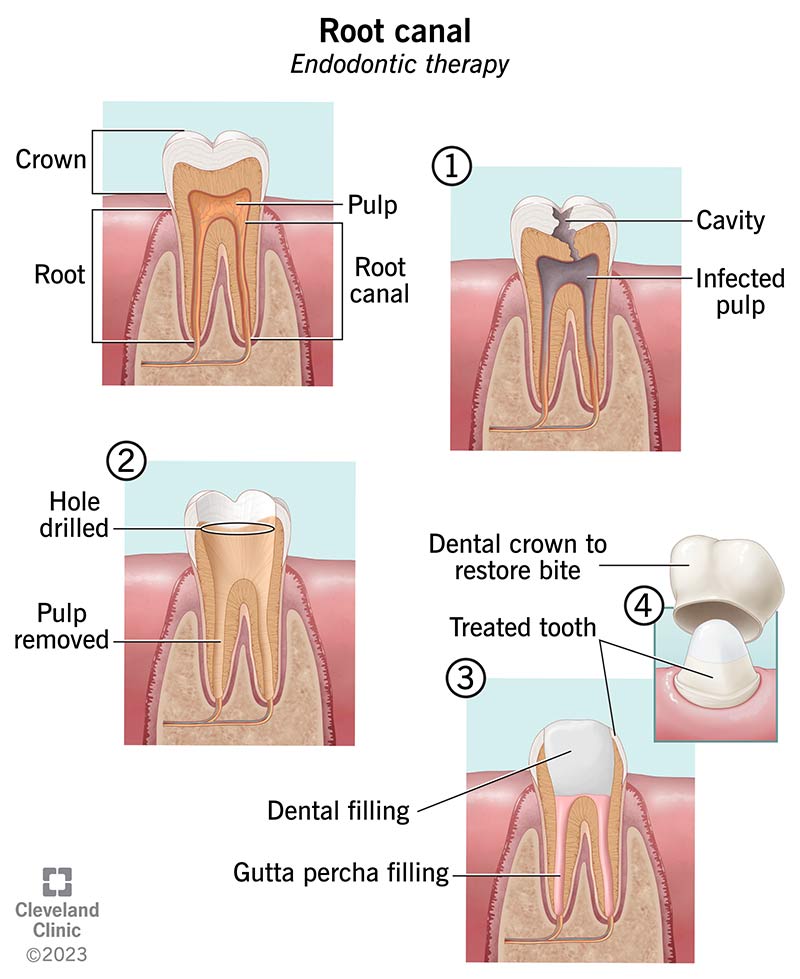A root canal is treatment for infections in tooth pulp, the innermost layer of your teeth. Endodontists and dentists do about 15 million root canals in the United States every year. Typically, root canals are painless treatments. You can avoid needing a root canal by brushing your teeth after meals, flossing daily and having regular dental checkups.

A root canal (endodontic therapy) is a dental treatment for infections in tooth pulp, the innermost layer of your teeth. Endodontists and dentists do about 15 million root canals in the United States every year. Often, you can avoid needing a root canal by taking care of your teeth.
You may need a root canal if bacteria inside your mouth invade the pulp inside your tooth and cause inflammation (pulpitis). Your tooth pulp may come under bacterial attack if:
If you have an infected tooth, you may need root canal treatment to clear out the infection. You can have infected teeth without symptoms. When you have symptoms, they may include:
Cleveland Clinic is a non-profit academic medical center. Advertising on our site helps support our mission. We do not endorse non-Cleveland Clinic products or services. Policy
Before beginning treatment, your dentist or endodontist will take dental X-rays of the affected tooth. They may do other tests to determine if your tooth pulp is dead, infected or inflamed and confirm that you’ll need a root canal. They may:
During root canal treatment, your dentist or endodontist removes the inflamed pulp. Then they clean and disinfect the inside of your tooth and place a filling on your tooth to seal the space.
Root canal treatment steps are:
Your provider may suggest you rest for a few minutes before leaving the dental clinic or provider’s office. It can take an hour or more for anesthesia to wear off, meaning your mouth and gums aren’t numb anymore. Some people decide to rest at home while that happens while others choose to go on with their usual daily routine.
Typically, you’ll have two more appointments so a provider can prepare your tooth for a dental crown and then place the crown on your tooth.
Root canals eliminate tooth infections that, left untreated, could cause serious issues like:
Sometimes root canals fail because they weren’t the right solution for your tooth infection. For example, if your tooth is very damaged, a root canal may not solve your issues. If your root canal fails, your healthcare provider will discuss other options:
Typically, it takes less than a week to recover from a root canal. Call your healthcare provider if your treated tooth hurts for more than a week.
Your tooth and gums go through a lot during a root canal. You can help them heal by:
Practicing good oral hygiene and having regular dental checkups are the best ways to avoid root canal treatment. Brushing and flossing your teeth gets rid of dental plaque — a sticky film of bacteria that can cause cavities. Regular dental checkups mean your dentist can spot cavities and other issues early on before they affect your tooth pulp.
Putting off root canal treatment increases the chance that:
Root canal treatment can be uncomfortable, mostly when your provider injects anesthesia into your gums and other parts of your mouth. Your provider wants you to be relaxed during treatment, so never hesitate to let them know if something hurts.
If you’re like most people, you’ll have less pain after treatment because it eliminated the infection that made your tooth hurt. Your tooth may feel sensitive for the first few days after treatment. That said, contact your provider right away if you have throbbing pain. Throbbing pain may mean there’s still infected pulp in your tooth.
A note from Cleveland Clinic
Notice a twinge in one of your teeth when you drink hot or cold liquids? Have a toothache that won’t go away? These may be signs you have an infected tooth and may need root canal treatment. These infections don’t heal on their own, so it’s important to talk to a dentist if you have ongoing tooth pain. If you need a root canal, your dentist or endodontist will explain the process so you know what to expect. You can avoid needing a root canal by brushing your teeth after meals, flossing daily and having regular dental checkups.
Last reviewed by a Cleveland Clinic medical professional on 11/20/2023.
Learn more about our editorial process.
Cleveland Clinic is a non-profit academic medical center. Advertising on our site helps support our mission. We do not endorse non-Cleveland Clinic products or services. Policy